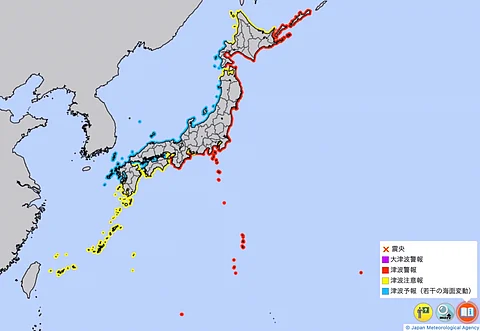

A colossal 8.8-magnitude earthquake off Russia’s Far East unleashed tsunami waves that struck coastal regions of Russia, Japan, and the United States, prompting urgent evacuations and alerts across dozens of Pacific nations.
The earthquake, centered 119 kilometers east-southeast of Petropavlovsk-Kamchatsky on Russia’s Kamchatka Peninsula, triggered tsunami waves as high as 3-4 meters in Kamchatka, flooding ports and washing fishing boats into the sea.
In Japan, waves up to 60 centimeters hit Hokkaido, while smaller waves of 20 centimeters reached Tokyo Bay.
Hawaii reported waves of up to 1.8 meters at Midway Atoll, prompting traffic jams in Honolulu as residents fled to higher ground.
“All the people are in the tsunami safety zone,” said Severokurilsk Mayor Alexander Ovsyannikov, confirming evacuations in Russia’s flooded North Kuril District.
Authorities in Japan, recalling the devastating 2011 tsunami, urged residents to seek high ground or evacuation centers immediately.
Tsunami warnings and advisories stretched from Russia to Latin America, with the U.S. National Weather Service issuing alerts for Hawaii, Alaska’s Aleutian Islands, and parts of California, Oregon, and Washington.
“A tsunami is not just one wave,” said Dave Snider, tsunami warning coordinator at the National Tsunami Warning Center in Alaska. “It’s a series of powerful waves over a long period of time.”
Japan’s Meteorological Agency downgraded alerts south of Fukushima but maintained advisories for northern coasts, warning that waves could persist.
In Hawaii, Governor Josh Green activated Black Hawk helicopters and high-water vehicles for potential rescues, urging residents to avoid coastal areas.
“This is a longitudinal wave with great force driving through the shoreline and into land,” Green said, emphasizing the waves’ destructive potential.
No major damage or serious injuries were reported, though Russian authorities noted minor injuries and power network checks following flooding in Kamchatka.
Japan’s nuclear power plants, including Fukushima Daiichi, reported no operational issues, with workers sheltering on higher ground.
The quake, among the strongest since Japan’s 9.0-magnitude event in 2011, disrupted transportation in Japan, halting ferries, trains, and airport operations.
“This is a subduction zone setting that has the potential to generate large tsunamis,” said Nathan Bangs, a research professor at the University of Texas Institute for Geophysics.
Pacific nations like the Philippines, Mexico, and New Zealand issued warnings for strong currents and surges, urging people to avoid beaches and harbors.
As aftershocks up to 6.9 magnitude continued, authorities emphasized the need for vigilance, with tsunami effects potentially lasting over a day.